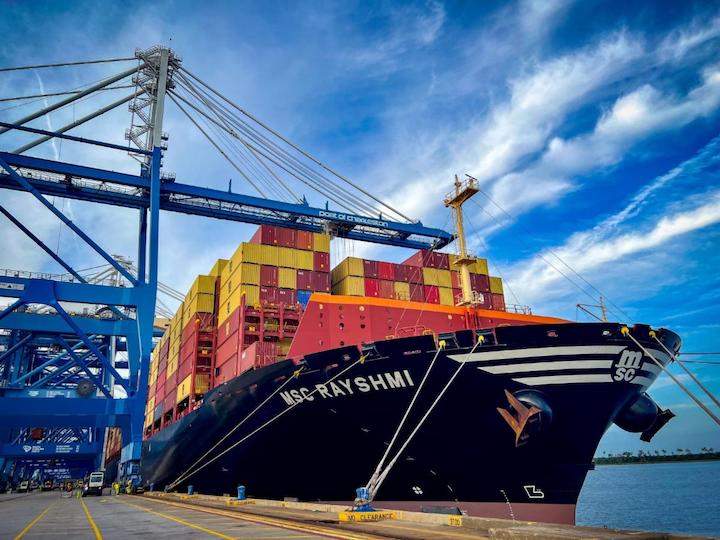South Carolina Ports efficiently handled a container ship at the deepest draft to-date, reinforcing the importance of Charleston Harbor’s new 52-foot depth.
The MSC Rayshmi recently set a record for deepest draft at SC Ports, arriving at 48 feet and 11 inches of draft. Five cranes — standing 155 feet above the wharf deck — worked the MSC Rayshmi at Wando Welch Terminal. Crane operators seamlessly moved 2,758 containers on and off the ship.

With four of the five deepening contracts already completed, Charleston now has a 52-foot depth leading up to its two biggest container terminals — Wando Welch Terminal and Leatherman Terminal. The 52-foot depth removes tidal restrictions for fully laden, post-Panamex vessels
The Charleston Harbor Deepening Project will wrap this fall. The remaining contract will yield a 48-foot depth to North Charleston Terminal.
“The Charleston Harbor Deepening Project will be completed faster than any project of its kind in the country,” Melvin said. “This amazing feat was made possible with the great support of Governor Henry McMaster, the South Carolina Legislature and the Congressional delegation, and through our strong partnership with the US Army Corps of Engineers, Charleston District.”
SC Ports continues to invest in key port infrastructure to support port-dependent businesses throughout South Carolina and beyond. In August, SC Ports handled 223,411 twenty-foot equivalents (TEUs) and 123,011 pier containers at Wando Welch Terminal, Leatherman Terminal and North Charleston Terminal.
SC Ports moved 16,410 vehicles at Columbus Street Terminal in August. Inland Port Greer and Inland Port Dillon handled a combined 12,977 rail moves last month.
To maintain fluidity in the supply chain, SC Ports has deployed creative solutions, such as opening gates seven days a week for motor carriers, prioritizing vessels with balanced imports and exports, and deploying thousands of chassis through SC Ports’ new SMART Pool.
“While supply chain challenges continue, ocean carriers and cargo owners can diversify their gateways to take advantage of SC Ports’ berth availability and terminal fluidity,” Melvin said. “We are applying the lessons we learned in the past year to implement responsive supply chain solutions to ensure we can efficiently handle cargo for exporters and importers throughout the Southeast.”











